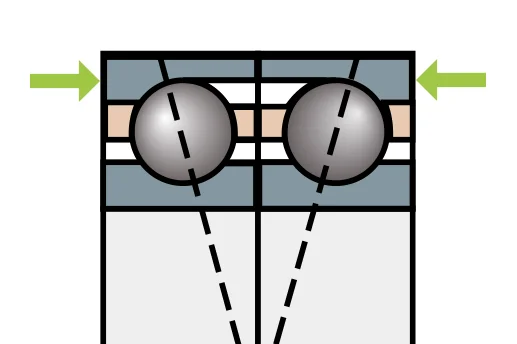What is meant by preloading a bearing?

Bearing load refers to the forces exerted on a bearing during operation and can affect how it operates; each bearing type can handle different specific loads. When we talk about preloading a bearing, we refer to a predetermined amount of axial force that’s applied to a bearing to align the bearing raceways. The force acts between the rolling elements and bearing rings and is not caused by an external load. It can be considered a negative internal clearance.
Why apply a preload?
Applying preload to a bearing eliminates the internal clearance found in standard ball bearings. Radial ball bearings are typically designed with some clearance for movement, but without preload, the rolling elements may slide rather than roll, increasing the risk of race misalignment. There are many reasons to apply preloads in bearings, often found in high-precision applications:
- Enhanced stiffness - reduces deflection under load, improving overall system rigidity.
- Reduced noise level - Ensures smoother operation, especially in high-speed applications.
- Improved shaft guidance - Prevents unwanted axial and radial movement, ensuring more precise operation.
- Extended bearing service life - Minimises internal play, reducing wear and increasing durability.
- Improved running accuracy - Provides better positioning accuracy in applications requiring tight tolerances.
- Prevent skidding in high-speed applications - Reduces the risk of roller skidding during rapid acceleration, deceleration, or in very light-load conditions.
Preloading is widely used in industries such as aerospace, robotics, and high-speed machinery, where even minor misalignment or movement can cause significant performance issues.
Preload in Angular Contact Ball Bearings
Single-row angular contact ball bearings are often mounted in sets to achieve preload. Bearings arranged in back-to-back or face-to-face configurations typically require an axial preload.
Find out more about the different bearing arrangements
For applications demanding high precision, matched and universally matchable bearings are precision-ground to ensure the correct preload when mounted together, eliminating the need for additional adjustment. However, factors such as interference fit, and operating conditions can still influence the final preload and must be considered.
Preload in Cylindrical Roller Bearings
Unlike ball bearings, cylindrical roller bearings can only be preloaded radially. Bearings with a tapered bore achieve preload by mounting the inner ring onto a tapered seat. This creates an interference fit, causing the inner ring to expand and achieve the required preload.
To ensure accurate preload, internal clearance gauges should be used during installation to precisely measure and adjust the fit. Proper handling during assembly is crucial, as incorrect preload can compromise bearing performance.
How to spot incorrect preload
If a bearing is preloaded incorrectly, it can lead to serious performance issues and premature failure. Here are key signs to watch for:
Excessive preload
Excessive preload can lead to excessive friction and heat within the bearing; this can damage the lubricant and, in turn, the bearing. This, in turn, leads to thermal expansion, higher torque, fatigue and premature wear.
Insufficient preload
Not having enough preload in your bearings often leads to excessive vibration, noise, and play. This causes imprecise operation, fretting of the raceways, and faster wear.
Getting Preload Right
For applications requiring extreme precision, ensuring the correct preload is essential for smooth, efficient operation. Too much preload increases wear and energy consumption, while too little can lead to instability and poor performance.
If you're unsure about the correct preload for your specific application, our bearing experts are here to help. Contact us today for expert advice on selecting the best bearing arrangement for your needs!
